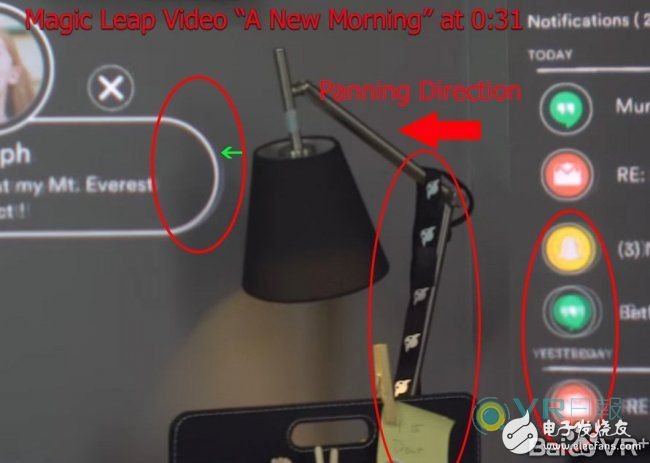What kind of display technology does Magic Leap use, at least what kind of display technology is used in their video? Xiaobian believes that the video itself has ruled out a series of possibilities, and then came up with a possible technology. Hint: Not all fiber laser scans mentioned in the Magic Leap patents and articles. Some people think that Magic Leap may deliberately release misleading videos to prevent us from mining relevant information, but Xiaobian doubts this. The display technology shown in the video is definitely the technology that is actually used in their prototypes. Someone told Xiaobian that Magic Leap uses a series of different levels of system, so the technology shown in the video is possible, and may not be possible in future products. Therefore, with these questions, the scientific worker Karl Guttag (hereinafter referred to as "I" or "we") began the analysis. Below is a screenshot of the video "A New Morining" uploaded by Magic Leap, when the user in the video is panning the head and the camera. Because the camera and display operate asynchronously, and/or results at different frame rates, this panning action causes instantaneous (time-based) frame shutter artifacts that appear as partial phantoms (the leftmost red circle green arrow refers to ). This frame, along with other artifacts that you didn't notice when playing the video, reveals a lot of information about the display technology used to generate the image. Please pay attention to the red circle on the left, you will notice the ghost/ghost phenomenon in the area indicated by the green arrow. This is where the camera captures during its screen refresh. Also in the red circle to the right of the screenshot, you will notice that the bottom three markers have a ghosting phenomenon, but the first one at the top is not (the second has a faint ghost). In contrast, the lamp arm of the middle circle does not exhibit ghosting, which confirms that this is a phenomenon that occurs during image generation processing. In addition to the screenshot above, we also analyzed the two videos "ILMxLAB and 'Lost Droids' Mixed Reality Test" and the original "Magic Leap Demo". Magic Leap said that these videos are "recorded directly through Magic Leap's technology... no special effects or synthetic effects." We want to confirm if there are other ghosts that might point to other display technologies. Based on the screenshot above and other video evidence, I think the following display technologies can be excluded: 1. Laser Fiber Scanning Display: Magic Leap's patents and related articles have appeared in one or more fiber scanning technologies (and their technical directors have been the technology of this aspect before joining Magic Leap). Cattle). Fiber-scanned displays are scanned in a spiral (or if they are arranged in a spiral array) at the "flyback/blanking" time, returning to the starting point. This blanking will show a black diagonal in the video, and/or flicker (similar to the old cathode ray tube showing a horizontal black retrace line). In addition, if it is a fiber laser scan, you will see laser speckle, but in fact we have not found it. Even if the image is out of focus, laser speckle will appear. There is no evidence in the screenshots and videos above that they have a laser, and there is a scanning process where blanking occurs. According to my research on laser beam scanning, no scanning process is found for both the still frame and the video. 2, Field SequenTIal DLP (field sequential digital light processing), or LCOS (liquid crystal liquid crystal): In the video or in any of the photos I took, I did not find the field sequential color scrolling, flashing or flashing. The so-called field sequential display means that only one color can be displayed at a time. When these fast gamut changes exceed the camera's scan/shutter process, we see color differences, and/or flicker, not a simple ghost. This is critical because there are reports that the production of LCOS equipment for the production of LCOS equipment is producing a projection engine for Magic Leap. Therefore, Magic Leap is either using the products of Qijing Optoelectronics or is changing the technology used. I have observed DLP and LCOS displays for many years, there are direct viewing, and there are many different types of videos and cameras. But I didn't find the use of field sequential color imaging in Magic Leap's video. 3. Laser Beam Scanning with a mirror: As with cathode ray tubes and fiber scanning, blanking/retreating occurs between frames, but it disappears over time. The reason I included this technology was just to make the options more complete. Here are the display technologies that Magic Leap might use: 1. Mico-OLED (approximately 10 companies are currently known to produce this display): Miniature OLEDs are used on silicon or similar substrates. The technology blog OLED-info has listed companies that are known to produce the display panel. (Epson has recently been added to this list, I guess Samsung and other vendors are doing research and development internally). I think Magic Leap has the potential to use miniature OLEDs: small enough to embed images into waveguides for small heads; with the display characteristics revealed in the above videos and images. 2, Transmissive Color Filter HTPS (Transmissive Color Filter High Temperature Polysilicon) (Epson): When Epson is still producing transmissive color filter HTPS devices, their head display has turned to the use of miniature OLED panels. In addition, although Meta's first-generation products use Epson's HTPS, they have switched to large-size OLED panels (with very large spherical reflector combiners). This technology presents challenges in achieving higher resolutions and sizes. Hydraulic Power Unit For Car,Hydraulic Lifter Remover,Electric Hydraulic Valve For Tractor,Car Lift Hydraulic Power Unit CHANGZHOU ROHN HYDRAULIC SCI-TECH CO.,LTD , https://www.rohnhydraulic.com
August 23, 2021